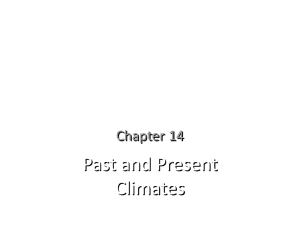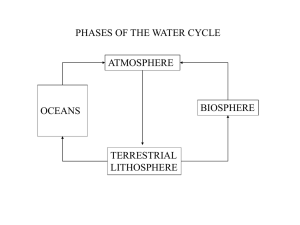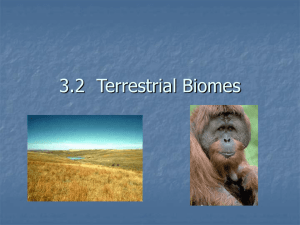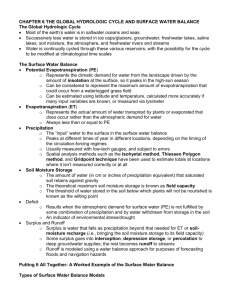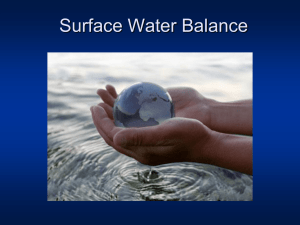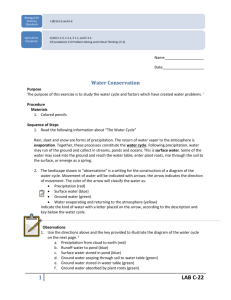File
advertisement
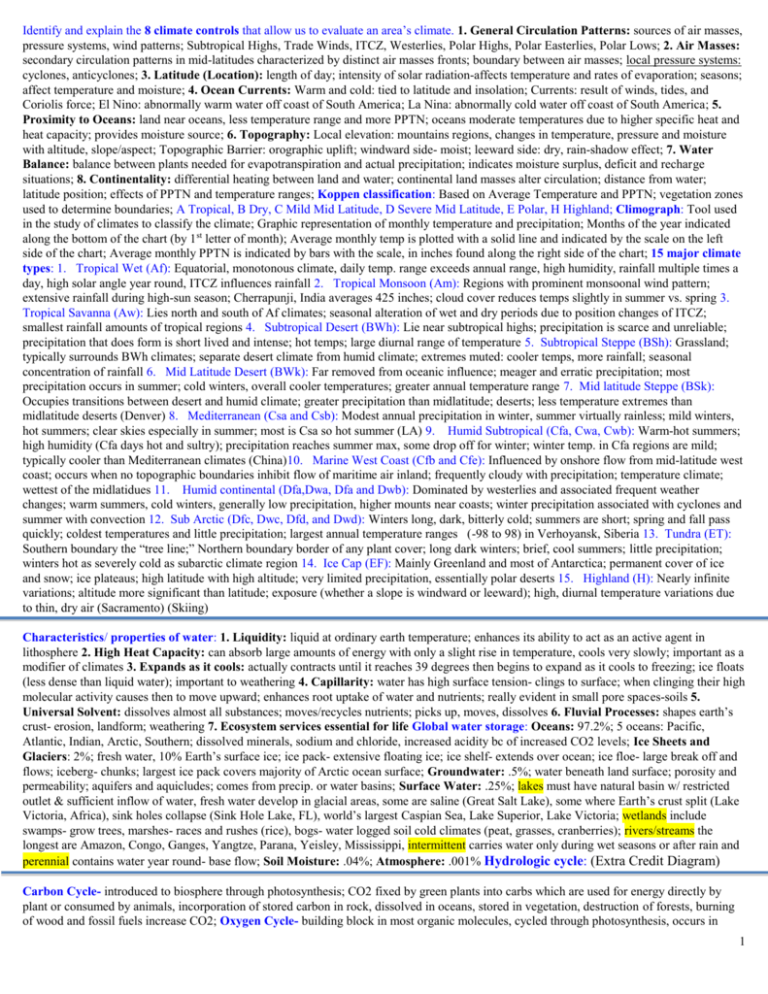
Identify and explain the 8 climate controls that allow us to evaluate an area’s climate. 1. General Circulation Patterns: sources of air masses, pressure systems, wind patterns; Subtropical Highs, Trade Winds, ITCZ, Westerlies, Polar Highs, Polar Easterlies, Polar Lows; 2. Air Masses: secondary circulation patterns in mid-latitudes characterized by distinct air masses fronts; boundary between air masses; local pressure systems: cyclones, anticyclones; 3. Latitude (Location): length of day; intensity of solar radiation-affects temperature and rates of evaporation; seasons; affect temperature and moisture; 4. Ocean Currents: Warm and cold: tied to latitude and insolation; Currents: result of winds, tides, and Coriolis force; El Nino: abnormally warm water off coast of South America; La Nina: abnormally cold water off coast of South America; 5. Proximity to Oceans: land near oceans, less temperature range and more PPTN; oceans moderate temperatures due to higher specific heat and heat capacity; provides moisture source; 6. Topography: Local elevation: mountains regions, changes in temperature, pressure and moisture with altitude, slope/aspect; Topographic Barrier: orographic uplift; windward side- moist; leeward side: dry, rain-shadow effect; 7. Water Balance: balance between plants needed for evapotranspiration and actual precipitation; indicates moisture surplus, deficit and recharge situations; 8. Continentality: differential heating between land and water; continental land masses alter circulation; distance from water; latitude position; effects of PPTN and temperature ranges; Koppen classification: Based on Average Temperature and PPTN; vegetation zones used to determine boundaries; A Tropical, B Dry, C Mild Mid Latitude, D Severe Mid Latitude, E Polar, H Highland; Climograph: Tool used in the study of climates to classify the climate; Graphic representation of monthly temperature and precipitation; Months of the year indicated along the bottom of the chart (by 1st letter of month); Average monthly temp is plotted with a solid line and indicated by the scale on the left side of the chart; Average monthly PPTN is indicated by bars with the scale, in inches found along the right side of the chart; 15 major climate types: 1. Tropical Wet (Af): Equatorial, monotonous climate, daily temp. range exceeds annual range, high humidity, rainfall multiple times a day, high solar angle year round, ITCZ influences rainfall 2. Tropical Monsoon (Am): Regions with prominent monsoonal wind pattern; extensive rainfall during high-sun season; Cherrapunji, India averages 425 inches; cloud cover reduces temps slightly in summer vs. spring 3. Tropical Savanna (Aw): Lies north and south of Af climates; seasonal alteration of wet and dry periods due to position changes of ITCZ; smallest rainfall amounts of tropical regions 4. Subtropical Desert (BWh): Lie near subtropical highs; precipitation is scarce and unreliable; precipitation that does form is short lived and intense; hot temps; large diurnal range of temperature 5. Subtropical Steppe (BSh): Grassland; typically surrounds BWh climates; separate desert climate from humid climate; extremes muted: cooler temps, more rainfall; seasonal concentration of rainfall 6. Mid Latitude Desert (BWk): Far removed from oceanic influence; meager and erratic precipitation; most precipitation occurs in summer; cold winters, overall cooler temperatures; greater annual temperature range 7. Mid latitude Steppe (BSk): Occupies transitions between desert and humid climate; greater precipitation than midlatitude; deserts; less temperature extremes than midlatitude deserts (Denver) 8. Mediterranean (Csa and Csb): Modest annual precipitation in winter, summer virtually rainless; mild winters, hot summers; clear skies especially in summer; most is Csa so hot summer (LA) 9. Humid Subtropical (Cfa, Cwa, Cwb): Warm-hot summers; high humidity (Cfa days hot and sultry); precipitation reaches summer max, some drop off for winter; winter temp. in Cfa regions are mild; typically cooler than Mediterranean climates (China)10. Marine West Coast (Cfb and Cfe): Influenced by onshore flow from mid-latitude west coast; occurs when no topographic boundaries inhibit flow of maritime air inland; frequently cloudy with precipitation; temperature climate; wettest of the midlatidues 11. Humid continental (Dfa,Dwa, Dfa and Dwb): Dominated by westerlies and associated frequent weather changes; warm summers, cold winters, generally low precipitation, higher mounts near coasts; winter precipitation associated with cyclones and summer with convection 12. Sub Arctic (Dfc, Dwc, Dfd, and Dwd): Winters long, dark, bitterly cold; summers are short; spring and fall pass quickly; coldest temperatures and little precipitation; largest annual temperature ranges (-98 to 98) in Verhoyansk, Siberia 13. Tundra (ET): Southern boundary the “tree line;” Northern boundary border of any plant cover; long dark winters; brief, cool summers; little precipitation; winters hot as severely cold as subarctic climate region 14. Ice Cap (EF): Mainly Greenland and most of Antarctica; permanent cover of ice and snow; ice plateaus; high latitude with high altitude; very limited precipitation, essentially polar deserts 15. Highland (H): Nearly infinite variations; altitude more significant than latitude; exposure (whether a slope is windward or leeward); high, diurnal temperature variations due to thin, dry air (Sacramento) (Skiing) Characteristics/ properties of water: 1. Liquidity: liquid at ordinary earth temperature; enhances its ability to act as an active agent in lithosphere 2. High Heat Capacity: can absorb large amounts of energy with only a slight rise in temperature, cools very slowly; important as a modifier of climates 3. Expands as it cools: actually contracts until it reaches 39 degrees then begins to expand as it cools to freezing; ice floats (less dense than liquid water); important to weathering 4. Capillarity: water has high surface tension- clings to surface; when clinging their high molecular activity causes then to move upward; enhances root uptake of water and nutrients; really evident in small pore spaces-soils 5. Universal Solvent: dissolves almost all substances; moves/recycles nutrients; picks up, moves, dissolves 6. Fluvial Processes: shapes earth’s crust- erosion, landform; weathering 7. Ecosystem services essential for life Global water storage: Oceans: 97.2%; 5 oceans: Pacific, Atlantic, Indian, Arctic, Southern; dissolved minerals, sodium and chloride, increased acidity bc of increased CO2 levels; Ice Sheets and Glaciers: 2%; fresh water, 10% Earth’s surface ice; ice pack- extensive floating ice; ice shelf- extends over ocean; ice floe- large break off and flows; iceberg- chunks; largest ice pack covers majority of Arctic ocean surface; Groundwater: .5%; water beneath land surface; porosity and permeability; aquifers and aquicludes; comes from precip. or water basins; Surface Water: .25%; lakes must have natural basin w/ restricted outlet & sufficient inflow of water, fresh water develop in glacial areas, some are saline (Great Salt Lake), some where Earth’s crust split (Lake Victoria, Africa), sink holes collapse (Sink Hole Lake, FL), world’s largest Caspian Sea, Lake Superior, Lake Victoria; wetlands include swamps- grow trees, marshes- races and rushes (rice), bogs- water logged soil cold climates (peat, grasses, cranberries); rivers/streams the longest are Amazon, Congo, Ganges, Yangtze, Parana, Yeisley, Mississippi, intermittent carries water only during wet seasons or after rain and perennial contains water year round- base flow; Soil Moisture: .04%; Atmosphere: .001% Hydrologic cycle: (Extra Credit Diagram) Carbon Cycle- introduced to biosphere through photosynthesis; CO2 fixed by green plants into carbs which are used for energy directly by plant or consumed by animals, incorporation of stored carbon in rock, dissolved in oceans, stored in vegetation, destruction of forests, burning of wood and fossil fuels increase CO2; Oxygen Cycle- building block in most organic molecules, cycled through photosynthesis, occurs in 1 many forms and released in many ways, sources include water, CO2, ozone, oxygen stored in rocks, crucial for life; Nitrogen Cycle- most cases must be “fixed” into “nitrates” a form that can be used by plants, some in atmosphere, but most by microorganisms in soil, only usable in gas form by few bacteria, nitrogen usable by other organisms as nitrates that are found in plants- nitrogen fixation, waste converts nitrates to waste nitrates, bacteria convert nitrates back to nitrates and nitrogen gas, use of nitrates in fertilizers for agriculture contributes to increased levels; Food Chains role in Biosphere: Direct passage of nutrients from one organism to another; Primary energy transformation mechanism; First level is producers second is consumers Biogeography: Ecology: the study of interactions among organisms with their particular habit or environment; Ecosystem: ecological unit or community of plants and animals generally in equilibrium with the inputs of energy and materials in a particular environment; Ecotone: gradual boundary zone between 2 ecosystems; Biome: large-scale highly generalized ecosystem type recognized on a global scale (usually on the basis of climatic influences); Niche: specific ways an organism actually functions in their particular habitat; Dynamic Equilibrium: diversity of plant life in an ecosystem working to achieve balance in energy flows. The ecosystem is constantly changing, building to equilibrium and then responding to changes brought its way, Succession: a series of communities that come into being in disturbed ecosystems. Each succeeding community alters the local microclimate and surface conditions, making possible the appearance of a new community; Environmental controls, Climate: temp, PPTN, wind, light, microclimates: local climate effects on veg and small areas diff from surrounding; Topography: elevation microclimates (upslope vegetation plants adapt to warm dry, downslope veg plants adapt to cool wet area), slope aspect (south facing receive more solar radiation, higher temps, warmer, drier & north facing cooler and less ET) so base of slopes grasses, shrubs, woodland, upslope: pines, grasses, down slope: mosses, ferns, maples; Soil: medium for plant growth, texture, structure, chemistry; Fire: certain have evolved with fire as major env. factor include pine forests, grasslands, Mediterranean with fire-resistant bark, dependent cone opening mechanism, stimulated seed germination, ladder-pines, veg changes that occur in areas where fires have been eliminated; Role of fire: Fire suppression leads to fuel layer build up making damage worse, loss of diversity, forests same age-old growth, not immediately reestablished a succession occurs; coniferous forests, prairie/savannah, deserts and deciduous forests not affected 8 major ways in which plants adapt: size, depth of root, leaf size and form, deciduous vs. coniferous, coverage, diversity, moisture (xerophytic adapted to dry conditions and hydrophytic adapted to wet conditions; hydrophytes live in water and hygrophytes love good drenching) competition, local variations, fire; 10 major vegetation biomes of North America: Tropical Rainforest: selva, greatest species diversity, very dense vegetation, little surface veg., fauna aboreal, lungs of our planet; Tropical Deciduous Forest: less tree density than selva, lower tree heights bc of less precip., distinct dry season, more ground level vertebrates and many aboreal; Tropical Scrub: subtropical steppe and trop savanna, extensive grasses, moderately tall trees, widely spaced, ground dwelling fauna; Tropical Savanna: trop grasslands, dominated by tall grasses, occasional bare ground, mixture of bushes and shrubs dot landscape, mix of fauna, Africa has “big game”; Desert: wide flora diversity, xerophytic flora, sparse plant cover typically shrubs (spiny thorny) moderately diverse fauna, no large animals, little rain; Mediterranean Woodland/Shrub: pronounced wet-dry climate, open grassland w/interspersed trees, chaparral shrub/woodland, summer wildfires; Mid-latitude Grassland: too dry for forests, too wet for desserts, perennials grasses dormant in winter, trees restricted to riparian areas, shrubs/bushes on rock sites, fire important; Mid-latitude Deciduous Forest: dense growth of broadleaf trees, widely modified by humans, diversity of fauna to match tropical regions, wildfire more limited during winter due to hibernation; Boreal Forest (Taiga): often colocated w/subarctic climate, most trees conifers, trees taller on southern side of this biome, limited faunal species diversity; Tundra: too cold for trees, dense, low height plant cover, animal life dominated by birds, few fish and mammals, no reptiles, alpine tundras exist at high elevations, short growing season; Mountains/Icecaps: highly variable, elevation, PPTN/wind, slope and drainage How soils develop: Weathering: soils develop on rock material that has been reduced to small fragments; Chemical modifications of water: water percolates through loose rock materials causing additional phys and chem modification; Organic activity: microorganism activity bring further changes, most soils rich w/life; Translocation: downward movement of material by water infiltration into the ground process by which various depths of soils develop over time; How soil profiles develop: Horizons form the soil profile, Eluvial Layer: horizon from which materials are being flushed or leached; Illuvial Layer: horizon in which fine particles leached from eluvial layer are deposited; SEQUENCE: 0: plant litter, raw humus at soil surface; A: dark color layer below O horizon, humus and organic matter; E: light colored horizon of max eluviation; B: horizon of illuviation where translocated material of A and E found, clay FE AL, humus; C: composed of parent material that is weathered material or loose deposits that have not been affected by soil forming processes; R: un-weathered bedrock; 5 factors that affect soil development: parent material (geologic factor), site (topography), organic activity, time, climate and vegetation; Four major soil properties: Texture: gravel, sand, silt, clay; loam: mix of sand, silt, and clay w/good structure for root growth; sandy soil: coarse-grained, permeable and absorb water easily but dry out rapidly; clay; Structure: det. by amount of clumping; platy, prismatic, blocky, granular, porosity and permeability; most plant grow best in loamy with a ped structure; Chemistry: complex chemical reactions in soil that determines presence and availability of nutrients; involves electrically charged ions in the soil; alkinity measured by pH; Color: organic matter=dark brown; oxidized iron w/oxygen=red & yellow; iron w/o oxygen=greenish/gray-blue; black=humus 2


